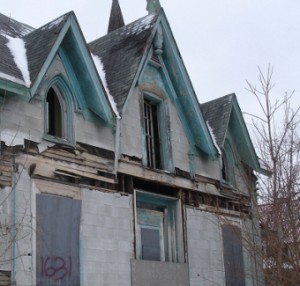
The 150-year-old gothic cottage has been the source of controversy between South Side residents and historical preservationists. (Justin Sondel)
When Will Morgan looks at the dilapidated house across the street from his South Salina Street property, he fumes with frustration.
“If we can get that thing out of the way then I feel that we can attract more people to come into the area,” Morgan said. “It distracts from my building.”
Morgan’s building is a house that he converted into three offices. The source of his frustration is a gothic cottage that stands at 1631 South Salina Street. The cottage has been there for around 150 years. It is the oldest structure in the South Salina historic district. And that venerable age has put it at the center of a controversy between neighbors who want to demolish it to redevelop the area and historic preservationists who want to save it.
“It is one of the few remaining gothic cottages around,” said Don Radke, the chairman of the Syracuse Landmark Preservation Board. “There used to be a lot more in central New York, and in the city specifically. And through a variety of activities over the years, most have them have been demolished.”
The building’s owner, New Jerusalem Church, has let the building fall into disrepair. Syracuse United Neighbors, a not-for-profit that advocates for the needs of low-income Syracuse residents, has asked the city to tear down the structure. Recently, the simmering dispute revived with legal action by the city.
On Feb. 4, the city department of code enforcement sent an official notice to the Syracuse Landmark Preservation Board, informing the preservation board of the city’s plans to take down the structure. At a meeting on Feb. 18, the board told the city to delay the cottage’s demolition house for 30 days. In that month, the preservation board will try to market the building to developers locally and nationally.
The preservation board will contact all parties who have expressed interest in restoring the house in the past, said Radke, the board chairman. It would also try to encourage its owners, New Jerusalem Church, to help out, he said. “We’re going to be contacting the church to see if the church, the owner, is willing to be a partner to this or just an opposition,” Radke said.
The New Jerusalem church owes $156,329 in back taxes, city records show. The church has been delinquent in paying the taxes for over two years, giving the city the right to seize the property. The city can also demolish the structure without seizing the property, which would likely happen if the board doesn’t find any interested developers, Radke said.
The city’s department of assessment only seizes a property when it has a buyer lined up, said David Clifford, a city tax assessor. The city is not interested in owning property that it is liable for and has to maintain, said Clifford. “The city doesn’t want to seize anyone’s property,” Clifford said. “We’d rather see them do their taxes. It’s basically a last resort when we can’t collect the taxes that are due.”
Earlier efforts to salvage the derelict cottage have failed. In 2000, for example, Syracuse Model Neighborhood Corporation launched an effort to restore the house. Tom Francis, the not-for-profit’s executive director, recalled gathering $225,000 from the city, from the state and from the state parks department to restore the cottage. But the city took six months to clear the title, Francis said, and in that time the contractor he’d employed raised his price to $260,000.
Francis asked the city to make up the difference. “They said no, so I wrote out a check and sent all the people’s money back,” Francis said.
An advocate for demolishing the building is Syracuse United Neighbors. The city should demolish the building because that’s the desire of those nearest the derelict cottage, said Rich Puchalski the group’s executive director. “The city just sits here and allows these vacant structures to exist,” he said.
The cottage’s frustrated neighbor, Will Morgan, agrees keeping dilapidated structures like the gothic cottage hold South Salina Street back. “I feel that Salina Street, and I know it is, is the busiest corridor in the city,” Morgan said. “And yet it’s the least used corridor.”
Morgan, 73, is a retired area planner for the city’s community development department. He bought the house across the street from the gothic cottage 15 years ago and converted it into three offices. He has a home inspection company and keeps its office in his renovated building across from the cottage.
Morgan has been a South Side resident since 1963. He remembers the neighborhood as a vibrant and busy place. He’d like to see it return to the busy center of commerce that he remembers, he says. He views the house at 1631 Salina Street as an obstacle for his community’s progress.
“If we can get that thing down,” Morgan said, “then I think we can get more people to come into the area.”
(Justin Sondel is a graduate student in magazine, newspaper and online journalism.)
-30-


